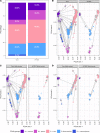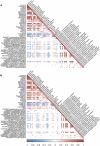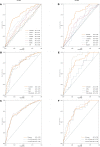Cervicovaginal microbiota and metabolome predict preterm birth risk in an ethnically diverse cohort
- PMID: 34255744
- PMCID: PMC8410012
- DOI: 10.1172/jci.insight.149257
Cervicovaginal microbiota and metabolome predict preterm birth risk in an ethnically diverse cohort
Abstract
The syndrome of spontaneous preterm birth (sPTB) presents a challenge to mechanistic understanding, effective risk stratification, and clinical management. Individual associations between sPTB, self-reported ethnic ancestry, vaginal microbiota, metabolome, and innate immune response are known but not fully understood, and knowledge has yet to impact clinical practice. Here, we used multi-data type integration and composite statistical models to gain insight into sPTB risk by exploring the cervicovaginal environment of an ethnically heterogenous pregnant population (n = 346 women; n = 60 sPTB < 37 weeks' gestation, including n = 27 sPTB < 34 weeks). Analysis of cervicovaginal samples (10-15+6 weeks) identified potentially novel interactions between risk of sPTB and microbiota, metabolite, and maternal host defense molecules. Statistical modeling identified a composite of metabolites (leucine, tyrosine, aspartate, lactate, betaine, acetate, and Ca2+) associated with risk of sPTB < 37 weeks (AUC 0.752). A combination of glucose, aspartate, Ca2+, Lactobacillus crispatus, and L. acidophilus relative abundance identified risk of early sPTB < 34 weeks (AUC 0.758), improved by stratification by ethnicity (AUC 0.835). Increased relative abundance of L. acidophilus appeared protective against sPTB < 34 weeks. By using cervicovaginal fluid samples, we demonstrate the potential of multi-data type integration for developing composite models toward understanding the contribution of the vaginal environment to risk of sPTB.
Keywords: Bioinformatics; Microbiology; Obstetrics/gynecology; Reproductive Biology; Translation.
Conflict of interest statement
Figures





References
-
- United Nations Inter-agency Group for Child Mortality Estimation. Levels and Trends in Child Mortality Report 2018. UNICEF; 2018.
-
- Chandiramani M, et al. Preterm labour and prematurity. Curr Obstet Gynaecol. 2004;14(5):309–319. doi: 10.1016/j.curobgyn.2004.06.002. - DOI
Publication types
MeSH terms
Substances
Grants and funding
LinkOut - more resources
Full Text Sources
Miscellaneous

